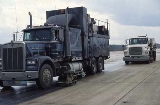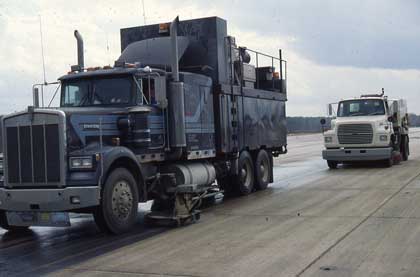
Airfield rubber removal
Encyclopedia
Airfield rubber removal, also known as runway
rubber removal, is the use of high pressure water, abrasives, chemicals and/or other mechanical means to remove the rubber
that builds up on airport
landing strips. The Federal Aviation Administration (FAA) specifies friction
levels for safe operation of planes and measures friction coefficients for the evaluation of appropriate friction levels. Individual airports incorporate rubber removal into their maintenance
schedules based on the number of take offs and landings that each airport experiences.

by the weight
of the airplane. The friction built up causes the rubber to polymerize and harden to the runway surface.
Macrotexture is visible to the naked eye. Without the aid of a microscope, microtexture can only be felt. The build up of rubber directly affects these variables and therefore reduces the friction available for landing which increase the possibility of hydroplaning of the landing airplane.

, high pressure and ultra high pressure work on the same principle of applying a spinning jet or set of jets to the surface to break the hardened rubber free from the runway surface. The main difference between the two is the pressure and flow. High pressure removal uses water at 2000 pound per square inch at up to 30 USgal/min while ultra high pressure removal uses up to 40000 psi (275,790,291.7 Pa) with a water usage between 8 USgal/min (Speidel, 2002, p. 4). High pressure and ultra high pressure water operations rely on the impact of water alone, with no chemicals used.
to the runway if not contained and cleaned up properly.
Runway
According to ICAO a runway is a "defined rectangular area on a land aerodrome prepared for the landing and take-off of aircraft." Runways may be a man-made surface or a natural surface .- Orientation and dimensions :Runways are named by a number between 01 and 36, which is generally one tenth...
rubber removal, is the use of high pressure water, abrasives, chemicals and/or other mechanical means to remove the rubber
Rubber
Natural rubber, also called India rubber or caoutchouc, is an elastomer that was originally derived from latex, a milky colloid produced by some plants. The plants would be ‘tapped’, that is, an incision made into the bark of the tree and the sticky, milk colored latex sap collected and refined...
that builds up on airport
Airport
An airport is a location where aircraft such as fixed-wing aircraft, helicopters, and blimps take off and land. Aircraft may be stored or maintained at an airport...
landing strips. The Federal Aviation Administration (FAA) specifies friction
Friction
Friction is the force resisting the relative motion of solid surfaces, fluid layers, and/or material elements sliding against each other. There are several types of friction:...
levels for safe operation of planes and measures friction coefficients for the evaluation of appropriate friction levels. Individual airports incorporate rubber removal into their maintenance
Preventive maintenance
Preventive maintenance has the following meanings:#The care and servicing by personnel for the purpose of maintaining equipment and facilities in satisfactory operating condition by providing for systematic inspection, detection, and correction of incipient failures either before they occur or...
schedules based on the number of take offs and landings that each airport experiences.

Source of airfield rubber build-up
When a plane lands, the tires are not spinning. The time it takes for the tires to get up to speed is referred to as "spin up time" (Speidel, 2002). During this time the tires are effectively dragging on the runway as well as being put under pressurePressure
Pressure is the force per unit area applied in a direction perpendicular to the surface of an object. Gauge pressure is the pressure relative to the local atmospheric or ambient pressure.- Definition :...
by the weight
Weight
In science and engineering, the weight of an object is the force on the object due to gravity. Its magnitude , often denoted by an italic letter W, is the product of the mass m of the object and the magnitude of the local gravitational acceleration g; thus:...
of the airplane. The friction built up causes the rubber to polymerize and harden to the runway surface.
Effects of rubber buildup
The build up of rubber affects the level of friction of the runway, most noticeable as a reduction in braking and ground handling performance. This can lead to incidents such as runway overrun or a lateral slide off the runway.
The contributing factors for viscous hydroplaning are a damp or wet pavement,
medium to high speed, poor pavement texture, and worn tire tread. If a runway
has good microtexture and grooving and the aircraft tires have a good tread
design, viscous hydroplaning could be alleviated.(NTSB, p.92)
Macrotexture is visible to the naked eye. Without the aid of a microscope, microtexture can only be felt. The build up of rubber directly affects these variables and therefore reduces the friction available for landing which increase the possibility of hydroplaning of the landing airplane.
Methods

High pressure water and ultra high pressure water
Sometimes referred to as hydrocleaningHydrocleaning
Hydrocleaning, high pressure cleaning or waterblasting is the use of water propelled at high speeds to clean surfaces and materials. By focusing and pressurizing the water stream, the force generated can remove, for example:...
, high pressure and ultra high pressure work on the same principle of applying a spinning jet or set of jets to the surface to break the hardened rubber free from the runway surface. The main difference between the two is the pressure and flow. High pressure removal uses water at 2000 pound per square inch at up to 30 USgal/min while ultra high pressure removal uses up to 40000 psi (275,790,291.7 Pa) with a water usage between 8 USgal/min (Speidel, 2002, p. 4). High pressure and ultra high pressure water operations rely on the impact of water alone, with no chemicals used.
Chemical removal
Cleaning the runway using chemicals involves the application of proprietary cleaners that are brushed into the surface of the runway and then washed off using low pressure water. There is a time between applying the chemicals and washing the runway when the chemicals are allowed to react with and break down the rubber. During this time the runway is unusable for landing operations and therefore could not be used safely in an emergency situation. The chemicals used can be expensive and require special handling. There are currently a newer generation of non-caustic rubber removal chemicals that are also environmentally superior, non-corrosive, non-toxic and relatively inexpensive to use. Some runway maintenance crews like the ability to do their rubber removal in-house using existing or lower cost machinery with a more regular, preventive maintenance program. Chemicals for rubber removal have proven to have no long-term effect on either asphalt or concrete runways. Using equipment to recover waste water/chemical/rubber allows control and safety of disposal with no runoff.High velocity impact removal
This method employs the principle of throwing abrasive particles at a very high velocity at the runway pavement surface, thus blasting the contaminants from the surface (Speidel, 2002). Also known as sandblasting, this method can introduce foreign object debrisForeign object damage
Foreign Object Debris is a substance, debris or article alien to a vehicle or system which would potentially cause damage.Foreign Object Damage is any damage attributed to a foreign object that can be expressed in physical or economic terms that may or may not degrade the product's required...
to the runway if not contained and cleaned up properly.

